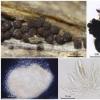
15-12-2025 07:09
 Danny Newman
Danny Newman
indet. Rutstroemiaceae sp. on unk. fallen leavesMc

15-12-2025 21:11
 Hardware Tony
Hardware Tony
Small clavate hairs, negative croziers and IKI bb

15-12-2025 15:54
 Johan Boonefaes
Johan Boonefaes
Unknown anamorph found on the ground in coastal sa

15-12-2025 15:48
 Danny Newman
Danny Newman
Melanospora cf. lagenaria on old, rotting, fallen

15-12-2025 07:05
 Danny Newman
Danny Newman
Pseudosclerococcum golindoi (det: Zotto)near Cosb

15-12-2025 11:49
 Danny Newman
Danny Newman
ITS sequences from the following two collections B

15-12-2025 12:34
 Danny Newman
Danny Newman
indet. Rhytismataceae on oak leafnear Purchase Roa

09-12-2025 12:06
 Andgelo Mombert
Andgelo Mombert
Bonjour,Je recherche l'article concernant Hypobryo
Este homgo lo encontré en la Sierras de Cazorla, Jaén, se que es Gibberella, pero no se cual puede ser. ¿Alguien tiene unas claves para Gibberella, o sabe cual podría ser?
Peritecios generalmente gregarios, que irrumpen de entre la corteza de Ulex parviflorus. Los peritecios son de color marrón con brillos metálicos, que en el microscopio son azul oscuro, de (268,92) 286,91 - 350,39 (368,74) µm. Me = 318,90 µm de anchura.
Ascas biseriadas, no amiloides, de (89,57) 91,35 - 113,78 (116,78) x (10,62) 12,77 - 14,72 (14,83) µm.
Me = 102,30 x 13,50 µm.
Esporas lisas, hialinas, algo curvadas, con 3 septos trasversales de; (20,26) 21,29 - 25,36 (27,38) x (6,12) 6,49 - 7,56 (8,00) µm
Q = (2,74) 2,85 - 3,65 (3,82) ; N = 33
Me = 23,23 x 7,09 µm ; Qe = 3,29
Gracias.
Saludos.
Salvador.
¿Tiene claves para Gibberella? si es así, le pido que me las envíe, por favor.
Yo he mirado en las claves que aparecen en MEDARDI G. (2006) Atlante fotografico degli Ascomiceti d'Italia. A.M.B. Fondazione Centro Sttudi Micologici. y me dice que G. pulicaris tiene esporas de 18-21 x 5-7 µm.
Gracias.
Saludos.
Salvador.

it is not easy to work with this genus, but compare also with Enrique Rubio's data here on ascofrance. In my opinion, after several collections of G. cyanogena and G. pulicaris, there is a difference in spore measurements: spores of G. cyanogena are smaller, often not more than 6µm broad. Length is rather variable between 21 and 31µm.
I do not really know but I think that G. pulicaris fruitbodies are always brown, like cacao, and G. cyanogena very dark brown to blackish brown.
I had a key for this genus, but unfortunately I am still working on organizing my data into an Excel list. For now I cannot find the doc (sorry for that).
regards,
björn
No te preocupes por las claves, ya me has ayudado bastante.
Saludos.
Salvador.

the genus Giberella is impossible without to know the anamorphs as you can see in the attached key.
Best regards,
Christian
Había leído algo sobre esto, pero tampoco estaba seguro. La dejaré como Gibberella aff. pulicaris.
Saludos.
Salvador.

Cordialement
Chris

 GIBBERELA-Samuels-G.-J.-H.-I.-Nirenberg-and-K.-A.-Seifert-0001.doc
GIBBERELA-Samuels-G.-J.-H.-I.-Nirenberg-and-K.-A.-Seifert-0001.doc